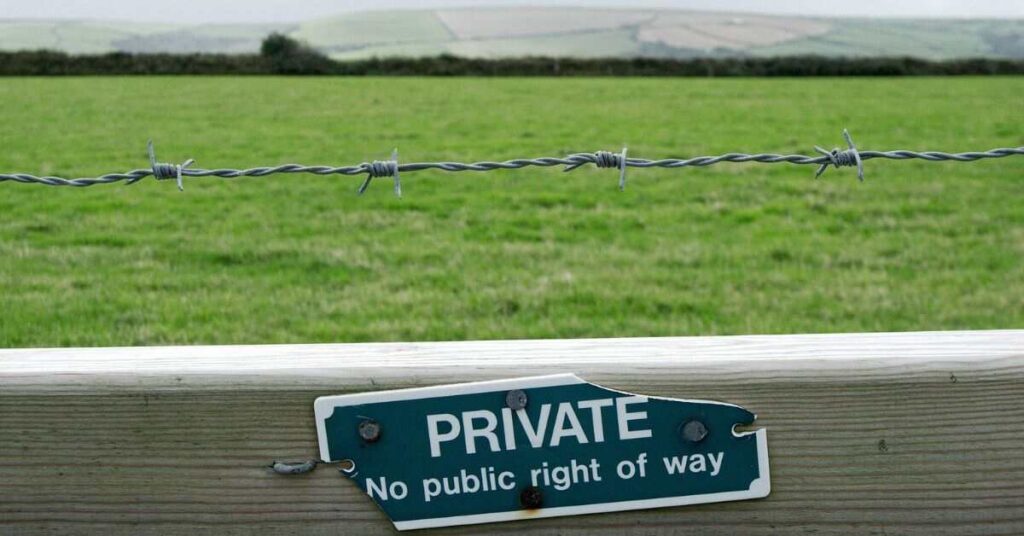ROW in real estate means “Right of Way.” It’s a legal right to cross someone else’s property. This can be for walking, driving, or utilities. ROWs are common in many neighborhoods.
ROWs can be public or private. Public ROWs include streets and sidewalks. Private ROWs might be shared driveways. They’re often marked on property maps. ROWs can affect property values.
ROWs have specific widths. A typical residential ROW is 50 feet wide. For major roads, it can be 100 feet or more. Homeowners must respect ROWs on their property. They can’t build structures that block a ROW.
Definition of ‘ROW’ in Real Estate
Right of Way (ROW) in real estate means the legal right to travel through someone else’s property. It allows people or vehicles to pass through a specific path on private land. This right is essential for infrastructure like roads and utilities.
In real estate, ROW refers to the authorized passage through a property. It ensures that landlocked areas have access and that services can reach all properties.
Key Concepts of ‘ROW’
Right of Way (ROW) gives the legal right to pass through someone else’s property. This right is crucial for roads, sidewalks, and utility lines. ROW ensures that essential services and pathways can reach all areas.
The legal implications of ROW affect property owners and buyers. ROW can influence property value and development potential. It may also impose responsibilities, such as maintaining access paths. Understanding ROW helps avoid legal disputes and ensures smooth real estate transactions.
Types of ROW in Real Estate
There are four main types of Right of Way (ROW) in real estate:
- Public Right of Way
- Private Right of Way
- Property Right of Way
- Pipeline Right of Way
1. Public Right of Way
Public Right of Way allows everyone to pass through certain areas. It is commonly used for roads, sidewalks, and public utilities. The government manages and maintains these pathways.
- Ensures access for the public.
- Maintained by local or state authorities.
- Essential for community infrastructure.
2. Private Right of Way

A Private Right of Way allows specific individuals or groups to pass through a property. This right is typically used for driveways or private paths.
The impact of a Private Right of Way includes granting access to neighbour’s or utility companies. It can also affect property value and usage. Agreements between property owners usually establish these rights.
- Grants access to specific individuals or groups
- Used for private driveways or paths
- Requires property owner agreements
- Can affect property value and usage
3. Property Right of Way
Property Right of Way (ROW) grants access through private property to others. It ensures that certain paths, like driveways or private roads, remain open for use.
Key Points:
- Grants specific individuals or groups access.
- Often established through legal agreements.
- Important for properties that need shared access.
4. Pipeline Right of Way
A Pipeline Right of Way (ROW) is a legal agreement allowing a pipeline to cross through private or public land. It ensures the safe and efficient transport of oil, gas, and other materials.
- Grants access for pipeline installation and maintenance.
- Landowners receive compensation for granting ROW.
- Ensures pipelines do not interfere with other land uses.
- Often involves safety regulations and inspections.
ROW and Property Development

ROWs impact property development. Developers must consider existing ROWs. They can’t build structures on ROWs. This affects site planning. ROWs may limit usable land area. They can influence building placement and design.
New developments may need to create ROWs. This could be for roads or utility access. ROWs must meet local regulations. They require proper legal documentation. Developers may need to negotiate ROWs with neighbors. This can affect project timelines and costs.
Legal Aspects of ROW
Legal aspects of ROW (Right of Way) are complex and important in real estate. ROWs are legally binding agreements. They’re recorded on property deeds. ROWs can be permanent or temporary. They may be created by easements, contracts, or government action. Here are key legal points:
- ROWs limit property rights
- Owners can’t interfere with ROW use
- ROWs may require compensation
- Disputes can lead to legal action
- Some ROWs expire, others are perpetual
Violating ROW agreements can result in fines or lawsuits. Property owners should understand their ROW obligations before buying land.
ROW in Urban vs. Rural Areas
| Aspect | Urban ROW | Rural ROW |
|---|---|---|
| Typical Width | Narrower (30-60 feet) | Wider (60-100+ feet) |
| Frequency | More frequent | Less frequent |
| Main Purposes | Roads, sidewalks, utilities | Highways, farm access, utilities |
| Complexity | Often more complex | Usually simpler |
| Impact on Property | Higher impact on land use | Lower impact on land use |
| Regulations | More stringent | Often more relaxed |
| Types | More varied (e.g., alleys, bike lanes) | Less varied |
| Maintenance | Usually by local government | Often shared responsibility |
ROW and Property Value

Right of Way (ROW) can affect property value in various ways. When ROW provides essential access or utilities, it can increase property value. However, if ROW restricts the use of land or decreases privacy, it can lower property value. The impact depends on the nature and location of the ROW.
ROW and Real Estate Transactions
Proper of way (ROW) plays a crucial function in real estate transactions. Customers and dealers must understand current ROW on a belongings, as it can affect access and use. Clear ROW agreements help avoid disputes and ensure smooth transactions.
During the sale process, title searches reveal any ROW. Buyers need to review these to assess any potential impact. Proper documentation and understanding of ROW are important for knowledgeable choice-making in actual property deals.
Related Content: UNDERSTANDING ADVERSE CONDITIONS IN REAL ESTATE: A COMPREHENSIVE GUIDE
What is a row in a project?
A row in a project is a linear path for utilities or transportation. It’s often called a “right-of-way” or ROW. ROWs can be for roads, pipelines, or power lines. They have specific widths, usually measured in feet.
Project ROWs need careful planning. A typical road ROW is 50 to 60 feet wide. Pipeline ROWs may be 25 to 150 feet wide. Power line ROWs can be up to 1,000 feet wide for major lines. ROWs must be surveyed and legally secured. They often require environmental assessments and permits.
Frequently Asked Questions
What does ROW stand for in real estate?
ROW stands for Right of Way.
How does ROW affect property value?
ROW can increase or decrease property value.
What are the types of ROW in real estate?
The main types are Public, Private, Property, and Pipeline ROW.
How is ROW acquired?
ROW is acquired through negotiation or eminent domain.
Why is ROW important in real estate transactions?
ROW affects property access and use, impacting transactions.
Final Thoughts
Understanding right of way (ROW) is critical for all people involved in real estate. ROW impacts property value, improvement potential, and legal responsibilities. It guarantees important services and pathways attain all regions, facilitating city boom and infrastructure improvement.
Proper knowledge of ROW allows property owners, buyers, and builders make informed selections and avoid prison disputes. Clear ROW agreements and compliance with policies ensure smooth real estate transactions and harmonious community residing.

Paul Mitchell, our website’s author, leverages 6 years of business expertise to provide insightful content. His wealth of experience enriches our platform, offering valuable insights for our readers.











